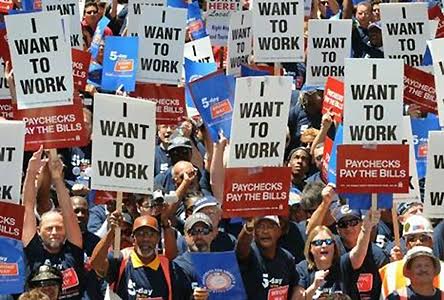
WASHINGTON (PAI) – The U.S. ended 2015 with an unemployment rate of five percent in December, the Bureau of Labor Statistics reported, as businesses claimed to create a net of 292,000 new jobs that month, and 2.7 million for the year.
December’s jobless rate was unchanged from the month before, but was down from 5.6 percent in December 2014. It was 6.7 percent in December 2013.
The number of jobless declined in December 2015 by 20,000, to 7.904 million, and that’s 800,000 fewer unemployed than at the end of 2014. But more than a quarter of the jobless (26.5 percent) had been out of work at least six months, meaning they’ve exhausted their unemployment benefits.
And in December one of every ten workers (9.9 percent) was unemployed, under-employed or so discouraged they stopped seeking work. That’s down from 11.2 percent at the end of 2014 and 13.1 percent at the end of 2013.
While the economy added jobs, the workers barely added to their paychecks. Average hourly earnings for all private-sector workers ended 2015 at $21.22, up 50 cents from 2014.
Two high-paying sectors, factories (+6,000) and construction (+45,000) added jobs in December, and gained jobs, net, last year. Factories employed 12.331 million workers in December, 30,000 more than a year before. Construction firms employed 6.538 million workers in December, up from 6.275 million the year before.
But many of the construction gains – 93,000 new jobs – came in the last two months of last year, and still left 645,000 construction workers (7.5 percent) unemployed at the end of 2015. Most of December’s and 2015’s construction gains were at specialty trade contractors and in buildings. There were 618,000 jobless factory workers at the end of 2015 (4 percent).
However, construction union leaders assert the official jobless figures for their industry understate joblessness there, since a worker toiling for one day during the BLS survey week is counted as employed for the entire month, even if he isn’t.
Services added many more jobs, with two low-paying occupations, health care (+39,000) and restaurants and bars (+37,000) leading the way in December. The restaurants and bars added 357,000 jobs in the year, more than factories and construction combined. Health care outdid all of them, adding 485,000 jobs in 2015, to 15.338 million.
“While the economy has improved, when you look at the peak in 2007 or the stronger economy of 2000, it is clear we still have a way to go before we reach full employment,” Economic Policy Institute analyst Elise Gould commented.
“Job gains in 2015 were slower than 2014, but they remained solid-slowly eating away at the slack created by the Great Recession. The unemployment rate, and the long-term unemployment rate, measurably declined,” she said.
The biggest jump in joblessness came in a small but high-paying sector: Mining, quarrying and oil extraction. The drop in oil prices led to layoffs at refineries and related industries. As a result, at the end of 2015, one of every nine workers in that sector – 104,000 – was unemployed, almost triple the number (45,000) and rate (4.1 percent) at the end of 2014.
And remaining workers in that field saw their earnings decline, too: From an average hourly wage of $26.63 at the end of 2014, to $26.51 at the end of last year.
Government added 17,000 jobs in December and 89,000 during the year, rising to 22 million. The federal government added 4,000 jobs in December and 17,000 jobs in the year. One third of them were in the Postal Service.
States added 6,000 jobs in December and 44,000 for the year, rising to 5.11 million total. Local governments added 7,000 jobs in December and 48,000 in the year, rising to 14.14 million. Local schools actually shed 7,000 from December 2014 to December 2015.
Photo: AFSCME blog












Comments